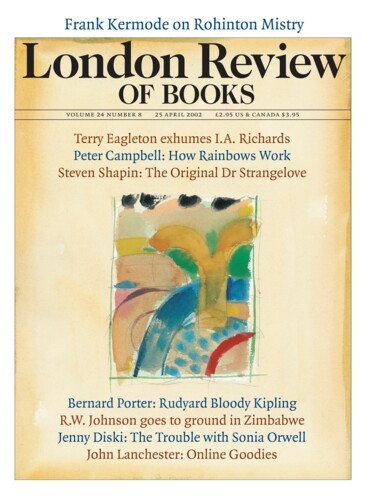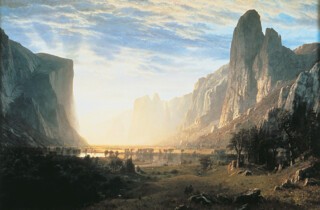Two exhibitions, one in London, the other in Grasmere, might have been framed to show how thinking and feeling have changed since the ‘death of God’ early last century. The landscape painters in American Sublime (at Tate Britain until 19 May) believed, as most people did, that the Earth was God’s creation and that its bones, its visible crust, were ‘a Book of Revelations in the rock-leaved Bible of geology’. Those were the words of the pioneering geologist John Wesley Powell, who led the first expedition through the Grand Canyon in 1873. Thomas Moran, an experienced painter from Philadelphia, travelled with Powell, and had been to Wyoming and Montana with the US Geological and Geographical Survey two years earlier. The chief fruit of his journeys were his paintings of the Yellowstone and Colorado canyons: 12 feet broad, 7 feet high, heroic displays of chiaroscuro in which dark stands of conifer and cliff frame a vista with a glowing core, a spotlit waterfall or rainstorm. In the distance, at the top of the picture, tranquil blues and greys stretch away to Paradise or the Pacific.
Contrast the paintings of Julian Cooper, whose exhibition Mind Has Mountains was put on by the Wordsworth Trust from late last year until earlier this month. These, too, are the fruit of an expedition, to Nepal in 1999. They make us look straight at the north faces of 8000-metre mountains. Nothing exists there but rock, ice and snow. In several there is no skyline or peak, therefore no glorious or terrifying goal. This mass of towering, buckled stone and fluted snow is the most unaccommodating zone on Earth, and the painter, in his own words, is ‘not trying to force an egotistical or mystical image upon it’.
The two exhibitions perhaps come closest – and it’s not very close – in Alfred Bierstadt’s Rocky Mountains, ‘Lander’s Peak’ (1863) and Cooper’s Kanchenjunga, North Face (2001, unfinished). In both a colossal mountain confronts us as it climbs by rock spurs and snowfields to a troubled sky. In both a lit area in the middle foreground helps to define our distance from the main object. Both have some sense of vista – a valley leads from our feet to the root of the massif. Here the resemblance ends. Bierstadt familiarises the landscape by detailing the branches and needles of the forest (savage enough, with a black bear crouched over a dead deer) and by painting a middle ground where sunny grey-blues and sap-greens define a river meandering through its flood-plain. Even the mountain is more Romantically interesting than truly formidable. Many of its spurs are prettily sunlit, and what they build up to is inspiring, apocalyptic, a burst of slanting sunbeams from a blue cloud-window.
Bierstadt seems to have had no avowed belief. Most of his colleagues did. The senior among them, Thomas Cole, wrote in his essay ‘American Scenery’ in 1835 that the wilderness mattered because it was the ‘undefiled works’ of ‘God the creator’. Frederic Edwin Church, the dominant talent, was devout. Explicitly religious or not, the painters had a tendency to uplift. The leading of our eyes to some lustrous or roseate goal is second nature to them. They tap deeply into that very 19th-century vision which found its mottoes in poetry. Longfellow’s ‘Excelsior’ is its war-cry, carried upwards by the ‘youth, who bore ‘mid snow and ice,/A banner with the strange device’. Its moral spirit seizes Tennyson’s ‘Ulysses’, whose hero is ‘strong in will/To strive, to seek, to find, and not to yield’. Both poems and paintings have in common a sense of the coherent and the guaranteed. An ennobling meaning somehow inheres even in the seemingly most chaotic passages of nature.
This is just not there in Cooper’s visions. Kanchenjunga, North Face is massively sombre, the palette confined to dull bronzes and whites with bluish and greenish tinges. The mineral world gets right into the painting by the addition of fine sand ‘to give tooth to the marks made by the brush’, and the act of painting gets into the image by the use of turpentine during Cooper’s reworking of the paint. The drips are left visible. This has the destabilising effect of re-enacting the movements of a huge rockface, when shattered stone is unlocked by thawing, rivulets of snow-melt, the collapse of seracs, the downrush of avalanches. These mountains exist entirely without our intervention. No sky alight with revelation crowns this picture, only a small triangle congested greeny-yellow by the monsoon, crammed against the top of the frame by the massif. There is no angelically blanched or divinely gilded summit up there on which to focus our fantasies. Cooper’s idea of mountains is superbly practical: they ‘always hold together visually really well, they have to physically, any surplus falls off.’
As I moved from picture to picture in American Sublime, with its many masterly images of mountain, cliff and forest, I was waiting for the disquiet that can arise when we find ourselves among the purely alien – sheer rock with no man-made steps or parapets to support us, forest or moor without paths to orient us and equip us with mental maps. Several of the pictures by the Hudson River School are entirely of wilderness, without even a browsing cow or an Indian brave posed on the rim of a waterfall to link them to our social world, our civilisation. But even these seem finally to reassure. The artist gives us a ‘view’ framed with so predictable a bordering of trees and clouds that I began to regret that Claude had ever flourished.
What none of them quite have is the daring of Turner. As early as 1812 his Snow Storm: Hannibal Crossing the Alps wrenches us sideways and upwards, then drops us into the white snow-glare. The composition is wholly original, according with no academic pattern. The welter of rocks and frozen snow in Cottage Destroyed by an Avalanche (1810) doesn’t roll predictably down a slope: it comes out at us from the right and the chief rock is affrontingly close. In Snowstorm, Avalanche and Inundation (1837), the lines of force swoop and collide at angles we have seen only in this painting; and although there is a distinct vortical pattern in Snowstorm – Steam-Boat off a Harbour’s Mouth . . . (1842), the waves, flakes and coal-smoke belly, swirl and surge at such unexpected angles you almost feel nausea as your eyes go with them. The toppling of the debris in Cottage Destroyed is painted with such physical freedom that it takes me back to a moment crossing a barely stable scree-chute on Liathach in Wester Ross, and my toes begin to curl. I am not suggesting we test the viewer’s pulse to gauge the power of a painting. I am suggesting that to get near to nature, landscape artists should free themselves of classical patterns and open themselves to the formations and forces that are actually there in the crags, storms and watercourses.
The sense of activity, of event as it happens, would be a welcome addition to Julian Cooper’s range. When I climbed Black Cleft on Goat Crag, Longsleddale with him some years ago, we were using a guidebook illustrated by his father, W. Heaton Cooper. I learned Cumbrian rock from the pencil sketches he had made for many years for the Fell and Rock Club’s climbing guides, with their dotted or broken lines for routes weaving round black-shadowed overhangs. Two years ago, with my climbing partner Chris Culshaw, I ‘posed’ for Julian Cooper on a route called Crenation Ridge on Scafell Pike as he took photographs in preparation for the painting which now hangs in the atrium of the Rheged Discovery Centre near Penrith. It’s big, about 15 feet square, and it hangs high above the viewers, making them crane up as though at an impending cliff. It’s unfinished, and the quite large figure of a hillwalker recently brushed in at the head of the gully suggests that the painter would like to show people grappling with the mountains. The final painting in the Mind Has Mountains catalogue* does this most unexpectedly. In Swing, Amjilassa (2000, in progress) a girl in a yellow blouse and brown sari swings on taut white lines from the invisible top of a bamboo framework. In front of her, a great gulf of air; beyond, a steep Nepalese hillside terraced with paddy-fields. The airiness, the suspendedness, the drop are composed to create the sheerness of the exhilaration and the perfect certainty of the arc. The mountaineer’s love of height and the bird’s-eye view have been seen beautifully, from another angle altogether.
Send Letters To:
The Editor
London Review of Books,
28 Little Russell Street
London, WC1A 2HN
letters@lrb.co.uk
Please include name, address, and a telephone number.


